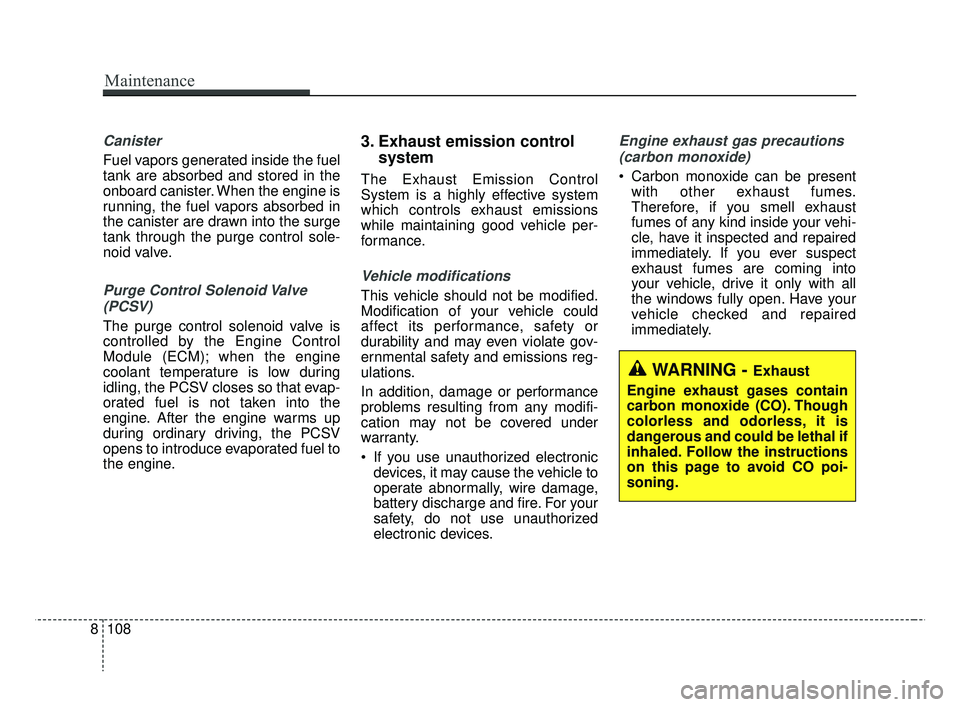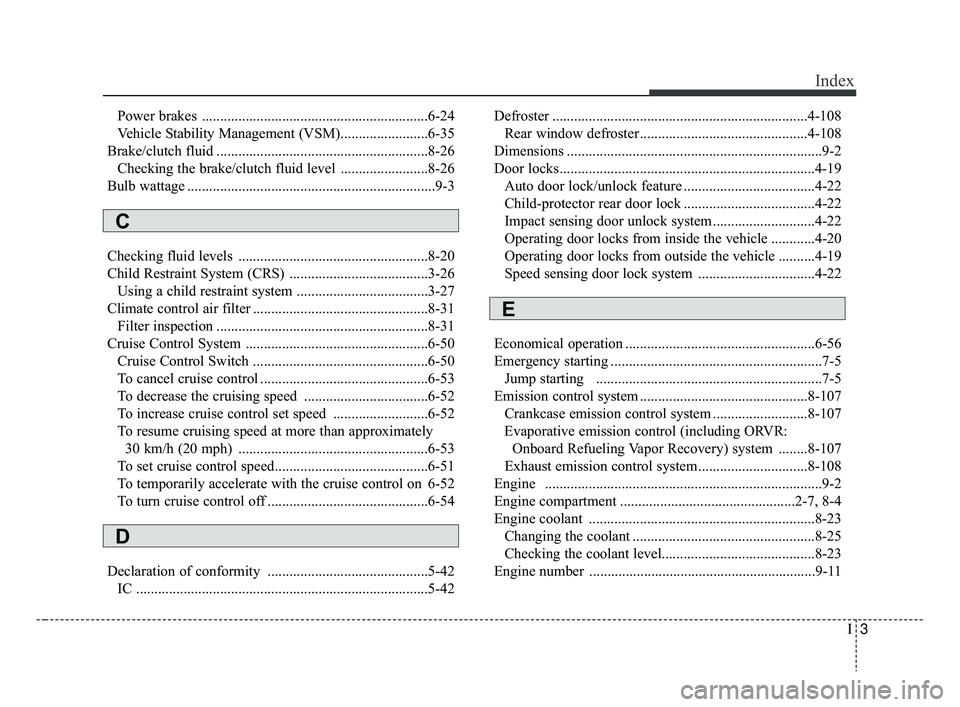Page 396 of 503

Maintenance
24
8
Check the condition and connections
of all cooling system hoses and
heater hoses. Replace any swollen
or deteriorated hoses.
The coolant level should be filled
between F and L marks on the side
of the coolant reservoir when the
engine is cool.
If the coolant level is low, add enough
specified coolant to provide protec-
tion against freezing and corrosion.
Bring the level to F, but do not over-
fill. If frequent additions are required,
see an authorized Kia dealer for a
cooling system inspection.
Recommended engine coolant
When adding coolant, use only
deionized water or soft water for
your vehicle and never mix hard
water in the coolant filled at the fac-
tory. An improper coolant mixture
can result in serious malfunction or
engine damage.
The engine in your vehicle has alu- minum engine parts and must be
protected by an ethylene-glycol
with phosphate based coolant to
prevent corrosion and freezing.
DO NOT USE alcohol or methanol coolant or mix them with the spec-
ified coolant.
Do not use a solution that contains more than 60% antifreeze or less
than 35% antifreeze. This would
reduce the effectiveness of the
solution.
✽ ✽
NOTICE
Make sure that the coolant cap is
properly closed after refilling the
coolant. Otherwise the engine could
overheat while driving.
OSC077016N
WARNING- Cooling fan
Use caution when working near
the blade of the cooling fan. The
electric motor (cooling fan) is
controlled by engine coolant
temperature, refrigerant pres-
sure and vehicle speed. it may
sometimes operate even when
the engine is not running.
SC CAN (ENG) 8.qxp 7/18/2018 5:33 PM Page 24
Page 397 of 503
825
Maintenance
For mixture percentage, refer to the
following table.Changing the coolant
Have the coolant changed by an
authorized Kia dealer according to
the Maintenance Schedule at the
beginning of this chapter.
OSC077017N
Ambient
Temperature Mixture Percentage
(volume)
Antifreeze Water
-15°C (5°F)35 65
-25°C (-13°F)4060
-35°C (-31°F)5050
-45°C (-49°F)6040
WARNING
Radiator cap
Do not remove the radiator cap
when the engine and radiator
are hot. Scalding hot coolant
and steam may blow out under
pressure which may result in
serious injury.
CAUTION
Put a thick cloth or fabric around the radiator cap beforerefilling the coolant in order toprevent the coolant from over-flowing into engine parts suchas the alternator.
SC CAN (ENG) 8.qxp 7/18/2018 5:33 PM Page 25
Page 480 of 503

Canister
Fuel vapors generated inside the fuel
tank are absorbed and stored in the
onboard canister. When the engine is
running, the fuel vapors absorbed in
the canister are drawn into the surge
tank through the purge control sole-
noid valve.
Purge Control Solenoid Valve(PCSV)
The purge control solenoid valve is
controlled by the Engine Control
Module (ECM); when the engine
coolant temperature is low during
idling, the PCSV closes so that evap-
orated fuel is not taken into the
engine. After the engine warms up
during ordinary driving, the PCSV
opens to introduce evaporated fuel to
the engine.
3. Exhaust emission control system
The Exhaust Emission Control
System is a highly effective system
which controls exhaust emissions
while maintaining good vehicle per-
formance.
Vehicle modifications
This vehicle should not be modified.
Modification of your vehicle could
affect its performance, safety or
durability and may even violate gov-
ernmental safety and emissions reg-
ulations.
In addition, damage or performance
problems resulting from any modifi-
cation may not be covered under
warranty.
If you use unauthorized electronic
devices, it may cause the vehicle to
operate abnormally, wire damage,
battery discharge and fire. For your
safety, do not use unauthorized
electronic devices.
Engine exhaust gas precautions
(carbon monoxide)
Carbon monoxide can be present with other exhaust fumes.
Therefore, if you smell exhaust
fumes of any kind inside your vehi-
cle, have it inspected and repaired
immediately. If you ever suspect
exhaust fumes are coming into
your vehicle, drive it only with all
the windows fully open. Have your
vehicle checked and repaired
immediately.
WARNING - Exhaust
Engine exhaust gases contain
carbon monoxide (CO). Though
colorless and odorless, it is
dangerous and could be lethal if
inhaled. Follow the instructions
on this page to avoid CO poi-
soning.
8 108
Maintenance
SC CAN (ENG) 8.qxp 7/18/2018 5:37 PM Page 108
Page 489 of 503

97
Specifications & Consumer information
RECOMMENDED LUBRICANTS AND CAPACITIES
To help achieve proper engine and powertrain performance and durability, use only lubricants of the proper quality.
The correct lubricants also help promote engine efficiency that results in improved fuel economy.
These lubricants and fluids are recommended for use in your vehicle.
LubricantVolumeClassification
Engine oil *1 *2 (drain and refill)
Recommends
Gamma 1.6L GDI3.5 l(3.7 US qt.)API Latest (ILSAC Latest)
Manual transmission fluidGamma 1.6L GDI1.6 ~ 1.7 l
(1.5 ~ 1.6 US qt.)
API Service GL-4 SAE 70W - HK SYN MTF 70W
- SPIRAX S6 GHME 70W MTF - GS MTF HD 70W
Automatic transmission fluidGamma 1.6L GDI6.7 l(7.1 US qt.)ATF SP-IV (Recommended MICHANG,
SK, NOCA, Kia genuine)
Coolant Gamma 1.6L GDI
M/T5.4 l (5.70 US qt.)Mixture of antifreeze and water
(Ethylene-glycol with phosphate
based coolant for cooling device)
A/T5.5 l (5.81 US qt.)
M/T : Manual transmission
A/T : Automatic transmission
SC CAN (ENG) 9.qxp 8/3/2018 5:47 PM Page 7
Page 496 of 503

I3
Index
Power brakes ..............................................................6-24
Vehicle Stability Management (VSM)........................6-35
Brake/clutch fluid ..........................................................8-26 Checking the brake/clutch fluid level ........................8-26
Bulb wattage ....................................................................9-3
Checking fluid levels ....................................................8-20
Child Restraint System (CRS) ......................................3-26 Using a child restraint system ....................................3-27
Climate control air filter ................................................8-31 Filter inspection ..........................................................8-31
Cruise Control System ..................................................6-50 Cruise Control Switch ................................................6-50
To cancel cruise control ..............................................6-53
To decrease the cruising speed ..................................6-52
To increase cruise control set speed ..........................6-52
To resume cruising speed at more than approximately 30 km/h (20 mph) ....................................................6-53
To set cruise control speed..........................................6-51
To temporarily accelerate with the cruise control on 6-52
To turn cruise control off ............................................6-54
Declaration of conformity ............................................5-42 IC ........................................................................\
........5-42 Defroster ......................................................................4-\
108
Rear window defroster ..............................................4-108
Dimensions ......................................................................9-\
2
Door locks......................................................................4-\
19 Auto door lock/unlock feature ....................................4-22
Child-protector rear door lock ....................................4-22
Impact sensing door unlock system ............................4-22
Operating door locks from inside the vehicle ............4-20
Operating door locks from outside the vehicle ..........4-19
Speed sensing door lock system ................................4-22
Economical operation ....................................................6-56
Emergency starting ..........................................................7-5 Jump starting ..............................................................7-5
Emission control system ..............................................8-107 Crankcase emission control system ..........................8-107
Evaporative emission control (including ORVR: Onboard Refueling Vapor Recovery) system ........8-107
Exhaust emission control system ..............................8-108
Engine .................................................................\
...........9-2
Engine compartment ................................................2-7, 8-4
Engine coolant ..............................................................8-23 Changing the coolant ..................................................8-25
Checking the coolant level..........................................8-23\
Engine number ..............................................................9-11
C
D
E
SC CAN (ENG) Index.qxp 7/18/2018 5:31 PM Page 3
Page:
< prev 1-8 9-16 17-24